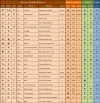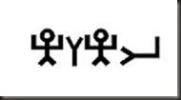I recently came across the argument that the Old Testament may not have originally been written in what we know as " Hebrew script".
I had not heard that view before and wondered if any of you were familiar with it? I know we here are more open to "outside the box" ideas than most. I feel more comfortable throwing out potentially "wacky" ideas to you than my pastors.
The idea seems to be based on several observations.
1. We seem to have older copies of the Septuagint (Greek language translation of Old Testament dated around 250BC) than we do "Hebrew originals". Our modern language translations used Hebrew manuscripts dating only to around 1000AD! These manuscripts come from Rabbis who explicitly deny that Jesus/Yeshua of Nazareth is the Christ.
2. A lot of scholars seem to believe that the written "Hebrew" language only dates back to around 500BC-ish, around the exhilic period. We don't seem to have older "Hebrew" texts.
Some books were certainly written around that time: Ezra, Malachi, Esther, Daniel,etc. Others were likely written around that time: Samuel, Kings, Chronicles, Jeremiah, Lamentations, etc.
Other books were obviously written many hundreds of years earlier: David's Psalms round 1000BC, and the Pentatouch by Moses around 1400ish BC.
Please understand that I am not questioning the Biblical authorship. I know Moses wrote the Torah, I know David wrote those Psalms, Solomon wrote most of Proverbs, etc.
I'm also not questioning the traditional dating.
I'm wondering about the script, the written language. If they were written in Hebrew, why don't we have older transcripts. If they were written in something else (like Egyptian hieroglyphics) why don't we find copies of that on pottery or whatever?
Here is one potential implication.
The site where I read about this theory is questioning (or even opposed to) the use of the Tetragrammaton (YHWH), and propose that it is a later innovation (perhaps added by Edomites during 2nd temple Judaism) and might not have been in the original text. They propose that it might even be the name of a foreign god, not the Name of the God of Abraham Isaac, and Jacob, the God and Father of our Lord Jesus Christ.
Please don't kill me. I am just throwing this out there.
It does seem bizarre that there are probably older Old Testament manuscripts saying "Theos" than "YHWH".
I had not heard that view before and wondered if any of you were familiar with it? I know we here are more open to "outside the box" ideas than most. I feel more comfortable throwing out potentially "wacky" ideas to you than my pastors.
The idea seems to be based on several observations.
1. We seem to have older copies of the Septuagint (Greek language translation of Old Testament dated around 250BC) than we do "Hebrew originals". Our modern language translations used Hebrew manuscripts dating only to around 1000AD! These manuscripts come from Rabbis who explicitly deny that Jesus/Yeshua of Nazareth is the Christ.
2. A lot of scholars seem to believe that the written "Hebrew" language only dates back to around 500BC-ish, around the exhilic period. We don't seem to have older "Hebrew" texts.
Some books were certainly written around that time: Ezra, Malachi, Esther, Daniel,etc. Others were likely written around that time: Samuel, Kings, Chronicles, Jeremiah, Lamentations, etc.
Other books were obviously written many hundreds of years earlier: David's Psalms round 1000BC, and the Pentatouch by Moses around 1400ish BC.
Please understand that I am not questioning the Biblical authorship. I know Moses wrote the Torah, I know David wrote those Psalms, Solomon wrote most of Proverbs, etc.
I'm also not questioning the traditional dating.
I'm wondering about the script, the written language. If they were written in Hebrew, why don't we have older transcripts. If they were written in something else (like Egyptian hieroglyphics) why don't we find copies of that on pottery or whatever?
Here is one potential implication.
The site where I read about this theory is questioning (or even opposed to) the use of the Tetragrammaton (YHWH), and propose that it is a later innovation (perhaps added by Edomites during 2nd temple Judaism) and might not have been in the original text. They propose that it might even be the name of a foreign god, not the Name of the God of Abraham Isaac, and Jacob, the God and Father of our Lord Jesus Christ.
Please don't kill me. I am just throwing this out there.
It does seem bizarre that there are probably older Old Testament manuscripts saying "Theos" than "YHWH".



